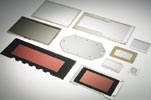

Optolite shielded filter windows have been designed for electronic displays, combining a high level of electromagnetic shielding with excellent contrast enhancement. They are used to minimise radio frequency emissions generated by enclosed electronic equipment and to protect electronic equipment from electromagnetic interference arising from external sources.
The windows feature up to 70 dB attenuation and are available in clear HSR (high scratch resistance) material or selected coloured bandpass filters to suit most displays. They come either flat or curved and offer impact abrasion, heat and chemical resistance. An optional blackened wire mesh is available to reduce mesh reflections. The mesh can be incorporated at any desired angle and edge termination services are available. The windows can be fabricated to customer requirements.
Typical applications include aerospace and defence, radio and telecommunications, industrial manufacturing equipment, medical and scientific apparatus, information technology equipment, and flat panel displays in electronic equipment.
Absorption of electromagnetic energy is mainly dependent on the mesh conductivity, wire diameter, weave density, electrical contact between intersecting wires, mesh material and edge terminations. The shield effectiveness, measured by using the ‘hole-in-the-wall’ technique, is typically between 60 dB and 70 dB from 100 kHz to 1 GHz and 35 dB up to 10 GHz for blackened stainless steel meshes.
As for optical characteristics, it is important to colour match bandpass filters to the particular display characteristics. Optolite transmission, absorption and reflectance are dependent on the filter bandpass colour, mesh density and non-glare finish. Also, by casting the material as a one-piece filter, the transmission is improved by reducing the number of internal reflecting surfaces from four to two, compared to laminated windows.
Overall standard thicknesses are 2,5 mm, 3 mm, 4 mm and 6 mm. Other, non-standard thicknesses, from 1 mm upwards, are also available to order together with an optional non-glare finish.
In one-piece filters, the conductive mesh is exposed along the edge of the Optolite filter after it is cut to size. A silver conductive busbar is added to the edge and then extended, if required, to the front or rear surface. The conductive circuit from the mesh is then completed either through the busbar or via a conductive elastomer gasket attached to the busbar. Other edge termination methods are also available.
The conductive gasket consists typically of aluminum or monel wires, which are crimped for maximum pressure. The wires are oriented perpendicular to the mating surfaces and integrally bonded into a silicone elastomer. The elastomer acts either as an environmental seal or as a pressure seal. Again, other types of gaskets are also available.
| Tel: | +27 11 608 3001 |
| Email: | [email protected] |
| www: | www.actum.co.za |
| Articles: | More information and articles about Actum Electronics |
© Technews Publishing (Pty) Ltd | All Rights Reserved